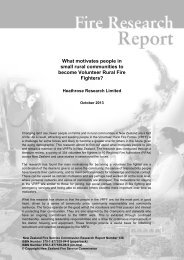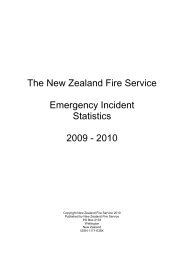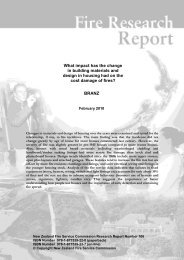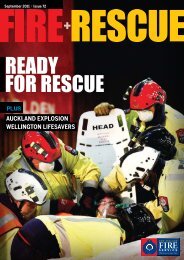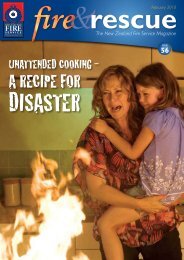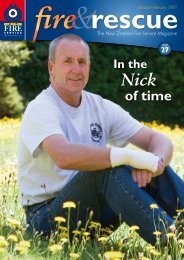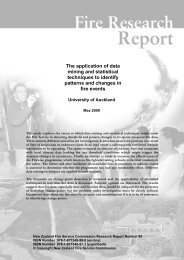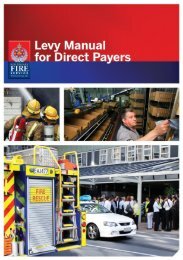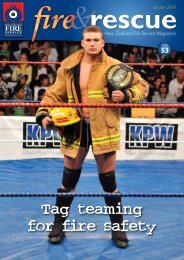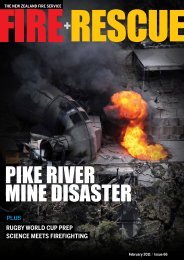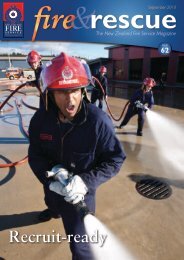Download PDF: Issue 83 - New Zealand Fire Service
Download PDF: Issue 83 - New Zealand Fire Service
Download PDF: Issue 83 - New Zealand Fire Service
Create successful ePaper yourself
Turn your PDF publications into a flip-book with our unique Google optimized e-Paper software.
September 2012 / <strong>Issue</strong> <strong>83</strong><br />
Whanganui<br />
Focus<br />
Plus<br />
IS It a bIrd…?<br />
InSIde pacIfIc helmetS
the new zealand fIre ServIce from crIme fIghtIng<br />
<strong>Fire</strong>+Rescue is the flagship<br />
publication of the <strong>New</strong> <strong>Zealand</strong><br />
<strong>Fire</strong> <strong>Service</strong>.<br />
It is produced by Media,<br />
Promotions and Communications,<br />
National Headquarters,<br />
Level 9, 80 The Terrace, Wellington.<br />
contrIbutIonS to fIre+reScue<br />
We welcome ideas for articles, news<br />
and events that would be of interest to<br />
other <strong>Fire</strong> <strong>Service</strong> staff and volunteers.<br />
Draft articles and photos (pictures<br />
need to be at least 1MB) can be<br />
emailed to fire.rescue@fire.org.nz or<br />
contact the editor Karlum Lattimore<br />
on 04 496 3702.<br />
Post written material and photos,<br />
or photo CDs to:<br />
<strong>Fire</strong>+Rescue magazine,<br />
PO Box 2133, Wellington.<br />
(These will be returned on request.)<br />
www.fIre.org.nz<br />
All material in <strong>Fire</strong>+Rescue magazine<br />
is copyrighted and may not be<br />
reproduced without the permission<br />
of the editor.<br />
ISSN: 1176-6670 (Print)<br />
ISSN: 1177-8679 (Online)<br />
front cover<br />
<strong>Fire</strong>fighters battle a roof fire at the<br />
Napier Ravensdown fertiliser works,<br />
Napier, Tuesday, July 31.<br />
KAMPIC / KeRRy MARSHALL<br />
2 / <strong>Fire</strong>+Rescue / September 2012<br />
to fire fighting<br />
Former Police Deputy<br />
Commissioner Rob Pope<br />
joins the <strong>Fire</strong> <strong>Service</strong><br />
this month as the first<br />
Director of the Office of<br />
the Chief Executive.<br />
The new role was put in place following<br />
the recent restructure of the NZFS<br />
senior management team. The role<br />
provides leadership for NZFS<br />
organisational strategic development,<br />
business planning, performance and<br />
accountability functions. He will also<br />
provide policy and strategic advice to the<br />
Chief Executive and the Commission.<br />
Rob retired from his Police career last year<br />
and has been working as a consultant.<br />
He said the NZFS is a good fit for his<br />
strategic and management skills and<br />
meets his personal commitment to serving<br />
the public.<br />
“There are strong similarities between the<br />
Police and <strong>Fire</strong>. The <strong>Fire</strong> <strong>Service</strong> is well<br />
recognised for its focus on communities<br />
and for the quality of its emergency<br />
response capability. I have great respect<br />
for the way firefighters and other staff<br />
engage with the public and I’m looking<br />
forward to meeting many of them.”<br />
Rob said the <strong>Fire</strong> <strong>Service</strong> had a great<br />
reputation and he was honoured to be<br />
given the opportunity to contribute to the<br />
organisation’s strategic direction.<br />
Rob has led some of <strong>New</strong> <strong>Zealand</strong>’s most<br />
high-profile police investigations including<br />
the death of 20-year-old Lisa Blakie in<br />
2000, the murders of Olivia Hope and Ben<br />
Smart in the Marlborough Sounds in 1998<br />
and the “poisoned professor” case in 1992.<br />
He was promoted to National Crime<br />
Manager in 2002, Wellington District<br />
Commander in 2004 and to Deputy<br />
Police Commissioner in 2006.<br />
The latter role included developing the<br />
Organised Financial Crime Agency and<br />
planning policing arrangements for the<br />
Rugby World Cup.<br />
NZFS Chief Executive Paul Baxter says<br />
he’s delighted to have secured Rob for his<br />
senior leadership team and looks forward<br />
to welcoming him when he takes up the<br />
role later this month (September).
learnIng<br />
opportunities<br />
Like other fire and rescue services<br />
around the world, we are coming<br />
under increasing scrutiny by<br />
Government, the public and courts for<br />
the way we conduct ourselves. Whether<br />
it is the way we manage public funds,<br />
the quality of our service to the public<br />
or the way we manage our health and<br />
safety responsibilities. As an<br />
organisation we are also expected, and<br />
are committed to, improving our<br />
performance wherever possible. This<br />
means making ever-more efficient use<br />
of our funding and making the most of<br />
every operational and organisational<br />
learning opportunity.<br />
Over the coming months, there will be<br />
considerable public and Government<br />
focus on the NZFS. I welcome that<br />
focus as an opportunity for us to learn<br />
and improve.<br />
The report from the Ministry of Civil<br />
Defence and Emergency Management<br />
of the Christchurch earthquake<br />
response will provide everyone involved<br />
with a broader insight into the overall<br />
response, inter-agency relationships,<br />
what worked well and what could be<br />
changed for the better.<br />
All agencies have already learned a<br />
lot as a result of their experience at the<br />
Christchurch earthquakes. By looking<br />
at the national disaster response,<br />
as a whole, agencies have another<br />
opportunity to tweak aspects of their<br />
operations or organisational practices<br />
so that they can be even better<br />
prepared for the next big disaster.<br />
I am also keen for our front line staff<br />
to seek out, and make the most of,<br />
any chance they get to train or work with<br />
other emergency services. We are being<br />
called to an increasing number of natural<br />
disasters or major incidents that require<br />
the close co-operation between many<br />
different responding agencies. The more<br />
we can build up our experience of<br />
working together, the better able we are<br />
to manage the big incidents.<br />
At the end of October, the Coroner’s<br />
inquest into the deaths at the CTV<br />
building will hear evidence relating to<br />
the death of Dr Tamara Cvetanova. As<br />
part of this hearing, the Coroner will be<br />
looking at the search and rescue effort<br />
at the CTV building. As you may know,<br />
her husband believes the rescue could<br />
have been done differently. The inquest<br />
will give the public an opportunity to<br />
learn the details of the search and<br />
rescue effort and should provide a<br />
better understanding of what everyone<br />
faced in the first few days.<br />
editorial<br />
Paul Baxter visits Wellington City Station.<br />
Shortly, we will also be releasing an<br />
independent review that has more<br />
closely examined aspects of the first 12<br />
hours of our response in Christchurch.<br />
We will work closely with staff in<br />
Christchurch, and further afield, to<br />
develop any local or national<br />
improvements that are recommended.<br />
It is my intention to take the outcomes<br />
of this second review and consider them<br />
alongside the actions that are already<br />
underway as a result of our operational<br />
response review. From there, we will<br />
decide how we will address any<br />
improvements that have been identified.<br />
Finally, you may also have heard that the<br />
Government is to review the functions<br />
and funding of the <strong>Fire</strong> <strong>Service</strong>. This<br />
review looks at ways to improve the<br />
insurance-based levy arrangement for<br />
funding the <strong>Fire</strong> <strong>Service</strong> and better<br />
recognise the broader, non-fire incidents<br />
we attend. It will also look at whether<br />
there are gaps or overlaps between<br />
emergency services. We support this<br />
review as the services we provide are far<br />
broader now than they were when the<br />
levy was first introduced. I believe we<br />
need a clearer mandate for the services<br />
we provide, and that our legislation<br />
needs to better reflect the reality of<br />
today’s fire and emergency service.<br />
Paul Baxter<br />
Chief Executive & National Commander<br />
<strong>Fire</strong>+Rescue / September 2012 / 3
<strong>New</strong> TAPS programmes<br />
for volunteers<br />
Volunteers around the<br />
country will get new,<br />
easier-to-follow training<br />
material next year.<br />
The National Training team started<br />
the project almost two years ago by<br />
talking with volunteers and trainers<br />
to find out what they needed and wanted<br />
from their training programmes. They then<br />
sat down with writers and NZFS subject<br />
matter experts to develop the new TAPS<br />
(Training and Progression System)<br />
material. This includes study guides,<br />
training and consolidation logs, trainer<br />
manuals and support material and brigade<br />
training guides.<br />
The new modules are a high octane<br />
concentration of the firefighting and<br />
incident-response essentials. The practical<br />
courses have also been changed to match<br />
the new material.<br />
Project co-ordinator Andrea Avelar<br />
said “Volunteers don’t have a lot of time<br />
to spend on studying, so we had to come<br />
up with training material to cover what<br />
they need to know, not what might be<br />
nice to know.”<br />
4 / <strong>Fire</strong>+Rescue / September 2012<br />
The new modules for Qualified <strong>Fire</strong>fighter,<br />
Senior <strong>Fire</strong>fighter and Station Officer are<br />
similar to the volunteer recruit training<br />
modules that were introduced in 2010.<br />
“We’ve had very positive feedback from<br />
recruits, who find the format and contents<br />
much easier to learn from than the dense<br />
modules of the past,” said Andrea.<br />
National Advisor Operations John<br />
Sutherland helped decide on some of the<br />
content of the new volunteer TAPS material.<br />
“The old training manuals have pages and<br />
pages of writing. They might take half a<br />
dozen pages to teach something that we<br />
have slimmed down into a couple of<br />
photographs, a few bullet points and a<br />
paragraph or so of writing,” he said.<br />
The final touches are now being put to the<br />
new training material. They will start being<br />
made available to volunteers early next<br />
year. Details on how the transition to the<br />
new programmes will be made will be<br />
released in a few months.<br />
Study guide illustrations for the Conducting<br />
Drills Module, featuring members of the<br />
Titahi Bay Brigade.
ealIgnment 2012<br />
What brigades can<br />
expect from their VSO<br />
A brigade’s vital link to resources,<br />
support, advice and information is<br />
their Volunteer Support Officer (VSO).<br />
The <strong>Fire</strong> <strong>Service</strong> has increased the number<br />
of VSOs to 52, who are evenly spread<br />
throughout the regions and working to the<br />
new position description.<br />
As an Area Manager, Brendan Nally has a<br />
special interest in volunteer brigades and<br />
is championing their needs in the<br />
transition to the new <strong>Fire</strong> <strong>Service</strong> regional<br />
structure. This includes helping VSOs and<br />
brigades understand what the newly<br />
defined role is expected to achieve.<br />
“The thing everyone has to keep in mind is<br />
that one of the key goals of the region<br />
restructure was to provide brigades with<br />
better support and for that support to be<br />
the same wherever they are in the<br />
country,” said Brendan.<br />
A VSO’s purpose is to help brigades to be<br />
operationally ready, to make sure the local<br />
fire risk is identified and managed, that<br />
brigade resources are organised and<br />
coordinated, and the sustainability of the<br />
brigade is maintained.<br />
“They are there to build capability, not<br />
dependency, within the brigades,” he said.<br />
The level of support each brigade needs<br />
will vary depending on the skill sets and<br />
make up of its members. It will be up to<br />
Area Managers to meet the brigades’<br />
differing needs; and they will be relying<br />
heavily on capable and effective VSOs to<br />
achieve this.<br />
The role has changed in some significant<br />
ways. VSOs will no longer deliver formal<br />
training. However, they will help arrange<br />
training and liaise with training officers<br />
when needed. Fleet and property-related<br />
work are also disappearing from the VSO’s<br />
workload as the transition takes hold. This<br />
work will be done by staff in the region<br />
service centres or contractors.<br />
“This frees up VSOs to really focus on their<br />
brigades. Brigades expect their VSO to be<br />
available to them, and to be<br />
knowledgeable, reliable, adaptable and<br />
capable. It is the responsibility of the<br />
NZFS to make sure these staff have the<br />
skills and enthusiasm to meet brigades’<br />
expectations,” said Brendan.<br />
Top: Titahi Bay Brigade members during a ladder drill.<br />
Above: Brendan Nally<br />
He accepts that it will take time to assess<br />
just what additional training and skill<br />
development individual VSOs may need to<br />
fully equip them for the new role. However<br />
this is a priority for Area Managers and a<br />
formal TAPS-like framework is proposed<br />
for the future.<br />
In the meantime, the transition period<br />
will allow everyone to gradually settle<br />
into their new roles until the new regime<br />
is fully implemented. This is likely to take<br />
some months.<br />
<strong>Fire</strong>+Rescue / September 2012 / 5
Pacific helmets<br />
behind the brim<br />
<strong>New</strong> <strong>Zealand</strong> firefighters<br />
can be confident their<br />
helmets will survive a<br />
hefty bash with a hunk<br />
of wood, a strike by a jet<br />
propelled ball bearing or<br />
being crushed between<br />
a rock and a hard place.<br />
They’ll also withstand flame and heat and<br />
electric shocks.<br />
‘Safety without compromise’ is the motto<br />
of Pacific Helmets – the makers of the<br />
<strong>New</strong> <strong>Zealand</strong> <strong>Fire</strong> <strong>Service</strong> firefighter’s<br />
helmet. And they put helmets coming off<br />
the production line through frequent<br />
random spot testing to make sure of it.<br />
The Whanganui manufacturer is a world<br />
leader. It supplies helmets to emergency<br />
services in over 80 countries and, as a<br />
result, has the biggest range in the world.<br />
It employs around 75 local people and<br />
almost all the raw materials used in the<br />
manufacturing process are locally sourced.<br />
6 / <strong>Fire</strong>+Rescue / September 2012<br />
Pacific Helmets has supplied helmets to<br />
NZFS since 1985 and will shortly start<br />
production on a new European style<br />
helmet which will serve as both a fire and<br />
rescue helmet.<br />
The business’s owner and Managing<br />
Director is David Bennett. David started<br />
out working for Suzuki in the 1970s when<br />
they were manufacturing motorbike<br />
helmets. He started as finance manager,<br />
moved up to general manager and then<br />
bought the company in 1982, changing the<br />
name to Pacific Helmets.<br />
Business Booms<br />
The turning point for the company came in<br />
the early 1990s when the new compulsory<br />
cycle helmet legislation was introduced.<br />
“We took on extra staff and had around<br />
100 people working seven days a week<br />
making thousands of helmets a month. In<br />
the last month before the cycle helmet law<br />
came into force we made 29,000 of a total<br />
exceeding 200,000 for 12 months.<br />
However, within a short time, competition<br />
from cheaper cycle helmet imports<br />
encouraged the company to shift its focus<br />
onto making only helmets for emergency<br />
services. “We had won a tender with the<br />
<strong>Fire</strong> <strong>Service</strong> in 1985 and decided to<br />
concentrate on that side of the business.”<br />
Then in 1990 the company sold new fire<br />
helmets to the London <strong>Fire</strong> Brigade, and<br />
this opened the way to market the designs<br />
internationally, especially in Europe.<br />
David’s son, Sales and Marketing Director<br />
Grant Bennett, said “In the next 12 months<br />
we expect to manufacture around 90,000<br />
helmets and supply to new distributors<br />
throughout the world.”<br />
He said there are huge differences in the<br />
international helmet designs and<br />
specifications. For instance, United States<br />
firefighters have been wearing the same<br />
helmet design for generations although<br />
there have been significant improvements<br />
to the resilience of the materials used<br />
to make them. The Japanese helmet has<br />
a completely different standard as their<br />
firefighters rarely enter a building that is<br />
on fire.<br />
new standard<br />
The new NZFS helmet is being made to the<br />
newly adopted Australia/<strong>New</strong> <strong>Zealand</strong><br />
standard for structure firefighting helmets.<br />
This standard combines the best<br />
features of both the European and US<br />
standards but is focused more on<br />
Australian/<strong>New</strong> <strong>Zealand</strong> conditions and<br />
operational philosophies.<br />
“The purpose was to improve safety and<br />
encourage firefighters to wear the helmet<br />
inside fire appliances,” said David.<br />
Most of the helmets made by Pacific<br />
Helmets are made of Kevlar and fibre glass<br />
around a plastic injection moulded liner.
We work very<br />
closely with the<br />
<strong>New</strong> <strong>Zealand</strong> <strong>Fire</strong><br />
<strong>Service</strong> to develop<br />
and trial new ideas<br />
and improvements.<br />
“We do our own research and development<br />
to keep up with new technology and<br />
changes in standards,” said David. The onsite<br />
laboratory contains a range of<br />
enclosed equipment for various tests,<br />
including a ballistic test (where a ball<br />
bearing is fired at a helmet), crush test<br />
equipment, flame and heat tests. There’s<br />
also a resistance and snap test to check<br />
the strength of chin straps.<br />
“We work very closely with the <strong>New</strong><br />
<strong>Zealand</strong> <strong>Fire</strong> <strong>Service</strong> to develop and trial<br />
new ideas and improvements, so we<br />
regularly send out prototypes to<br />
firefighters for them to trial and send in<br />
their feedback. It’s a great way to make<br />
sure what we are doing really meets the<br />
needs of the people who’ll be wearing<br />
them,” he said.<br />
The new NZFS fire and rescue helmet will<br />
start to be issued as a replacement helmet<br />
later this year.<br />
Top: Staff assemble a variety of helmets for different<br />
customers. Middle: Grant Bennett shows off the<br />
crush test dummy in the lab. Right: David Bennett,<br />
founder of Pacific Helmets.<br />
<strong>Fire</strong>+Rescue / September 2012 / 7
Feature<br />
Focus on<br />
whanganui<br />
The two outlying suburbs of Whanganui can’t be reached within the ideal NZFS<br />
response time of eight minutes so Acting Area Manager Gary Ward has a plan.<br />
He’s working with the station crews to<br />
set up a programme of community<br />
education, including home fire<br />
safety checks and smoke alarm detection.<br />
“We want to encourage residents in<br />
Castlecliff and Aramaho to reduce their fire<br />
risk and make sure they have early warning<br />
if there is a fire,” he said.<br />
The urban turnout area from the Whanganui<br />
station stretches for over 4.5 km in one<br />
direction to Castlecliff and 7.4 km in the<br />
other to the outer edges of Aramaho.<br />
Whanganui station has two crews on duty<br />
24/7 and Gary says they have to be pretty<br />
self-reliant.<br />
“Our nearest backup is the volunteer<br />
brigades at Ratana and Waitotara but both<br />
struggle with day crewing. So, often, our<br />
backup is the brigades from Marton and<br />
Bulls. We have to accept that the two<br />
pumps will be on their own for at least 20<br />
minutes before help can arrive at a major<br />
8 / <strong>Fire</strong>+Rescue / September 2012<br />
incident.” He says this has led to the guys<br />
learning to make do with the resources<br />
they have.<br />
Whanganui Area has 14 volunteer brigades<br />
and a career station with operational<br />
support volunteers. Gary Ward is in<br />
charge for the time being. He recently took<br />
over from newly retired Area Manager<br />
Kevin Smith, who left with 44 years under<br />
his belt. In Whanganui, the Area Manager<br />
is also the Principal Rural <strong>Fire</strong> Officer,<br />
so Gary also has responsibility for<br />
managing the rural fire risk, working<br />
closely with the local district council.<br />
With two main state highways through the<br />
area there is the potential for some gnarly<br />
accidents, particularly on State Highway 4<br />
through the winding hills to Raetihi and<br />
Ohakune. The brigades and Whanganui<br />
station turn out to over 150 rescue<br />
emergencies in the area each year, and<br />
attended a total of almost 1,400 incidents<br />
last year (2011/2012).<br />
whanganui Brigade incidents<br />
Gary was appointed Assistant Area Manager in Whanganui in 2009.<br />
He arrived in <strong>New</strong> <strong>Zealand</strong> in 2000 after spending 10 years in the<br />
Hampshire <strong>Fire</strong> and Rescue <strong>Service</strong> and prior to that he was a<br />
firefighter with the British Naval Air Command. His first position on<br />
arrival in <strong>New</strong> <strong>Zealand</strong> was as a training officer and then he took over<br />
management of simulation training. “Having a diverse background<br />
and appling it to my current role gives me a different perspective,<br />
and I’ve used what I have learned.”<br />
450<br />
400<br />
350<br />
300<br />
250<br />
200<br />
150<br />
100<br />
50<br />
0<br />
2009 2010 2011 2012<br />
Structure <strong>Fire</strong><br />
Other <strong>Fire</strong><br />
Medical<br />
Rescues<br />
False Alarms<br />
Other
away from StatIon<br />
There’s a big advantage to<br />
working in the Whanganui station<br />
– it’s not too far from the big outdoors.<br />
And at least two of the staff are making<br />
the most of the lifestyle offered by the<br />
surrounding countryside.<br />
Just a few minute’s drive north from<br />
Whanganui is the turnoff to Makirikiri<br />
Valley. Part of the area is home to one of<br />
the country’s first fallow deer herds. For<br />
Station Officer Aaron Summerhays, deer<br />
stalking is a passion and he’s now offering<br />
up his services as a hunting guide.<br />
“I have an arrangement with a local<br />
farmer with 2,500 acres of land where<br />
we can shoot on.”<br />
Aaron is particularly interested in taking<br />
out family groups. “I have been hunting<br />
since I could walk in gumboots and got<br />
my firearms licence at 16. Since then<br />
I’ve been out hunting all over the country<br />
and I’m keen to pass that knowledge<br />
on to the younger generation.” He has<br />
been focusing on father and son (or<br />
daughter) guided trips.<br />
Aaron’s wife Sarah and oldest daughter<br />
Briar are also deer stalkers. “My two<br />
youngest children are keen to come out<br />
but they’re too little and looking after<br />
them holds Sarah back a bit as well.”<br />
Aaron Summerhays and two youngsters<br />
who had a great time out on their first hunt.<br />
The family makes the most of the<br />
venison he brings home and he’s now<br />
about to build a shed where he can do<br />
his own processing and make sausages<br />
and salami.<br />
Aaron’s most memorable hunt was in<br />
the central North Island on a cold and<br />
frosty April morning. He could hear two<br />
red stags roaring in the distance and<br />
began approaching stealthily. Just as<br />
he got to the crest of a hill one of the<br />
stags came bellowing up the other side.<br />
“A quick shot stopped it in its tracks only<br />
seven metres away from me,” said Aaron.<br />
“I could still hear the second stag and<br />
crossed over a gorge to find it. It was a<br />
better trophy so I managed to roar it up<br />
into a small clearing to get my shot.”<br />
He was at least five kilometres away<br />
from his quad bike and could see he had<br />
a tough job ahead to get his deer out of<br />
the bush.<br />
“But it was my lucky day. Just as I was<br />
working out what to do, a helicopter<br />
landed in the clearing. The pilot was<br />
dropping off another hunter and after<br />
he congratulated me on my 12-pointer,<br />
he flew me and the deer back in two trips<br />
to my quad.”<br />
pet project<br />
Feature<br />
Also up the Makirikiri Valley is Senior<br />
Station Officer Bryce Coneybeer’s<br />
new project – a pet crematorium.<br />
Like a lot of firefighters, Bryce is quick to<br />
build or fix just about anything he wants.<br />
But he was beaten into submission by the<br />
red tape when it came to building his own<br />
pet crematorium and ended up having to<br />
import one from England.<br />
Bryce and his wife Sandy live off the grid<br />
up the valley, running their home on solar<br />
power and doing all their cooking on a<br />
wood-fired stove which also heats their<br />
hot water. The crematorium is dieselheated<br />
to 850-1,000 degrees.<br />
“There’s no facility like this in Whanganui<br />
and until I came along the SPCA and dog<br />
pound had been taking their euthanased<br />
animals to the rubbish tip, which isn’t<br />
ideal. We give them a much better send off<br />
and bury the ashes on our land,” he said.<br />
Bryce is also considering setting up a<br />
remembrance garden for people who need<br />
somewhere to bury their pet’s ashes. He<br />
hasn’t got a name for the pet crematorium<br />
yet and is open to suggestions.<br />
Whlle Bryce couldn’t build a compliant<br />
crematorium he has used his engineering<br />
skills to develop some of the other essential<br />
equipment for his project – a special<br />
vacuum cleaner and a grinding machine.<br />
Now that this project is up and running, he’s<br />
turning his attention to the possibility of<br />
another, involving water tanks.<br />
Bryce Coneybeer and the nervous-looking family<br />
pet Chuck atop the crematorium.<br />
<strong>Fire</strong>+Rescue / September 2012 / 9
Feature<br />
SanSon Safer<br />
with smoke alarms<br />
During a recent home fire safety blitz by the Bulls Brigade, one volunteer was chased<br />
into a house by an angry sheep while another resuscitated a dog that had collapsed.<br />
The townships of Bulls and Sanson are five<br />
kilometres apart and the brigade responds<br />
to around 70 calls a year in the two towns.<br />
A few years ago, the brigade visited all the<br />
homes in Bulls to provide a home fire safety<br />
check and install smoke alarms in sleeping<br />
areas and hallways. They took with them a<br />
collection of pamphlets and materials from<br />
various government and local agencies to<br />
alert residents to various services and<br />
assistance that were available.<br />
10 / <strong>Fire</strong>+Rescue / September 2012<br />
Chief <strong>Fire</strong> Officer Brian Carter said “It took<br />
us over two years to visit all the Bulls<br />
homes because the project ran out of<br />
funds half way through.” After finishing<br />
that project, the guys took a bit of a break,<br />
and then picked up the task of installing<br />
smoke alarms in Sanson.<br />
“The Sanson community were really<br />
enthusiastic and raised $12,500 from their<br />
weekly markets to pay for the alarms. We<br />
have just finished installing one long life<br />
alarm in every hallway and an ordinary<br />
photoelectric alarm in every bedroom or<br />
sleeping area.”<br />
With 250 houses to cover the brigade<br />
divided the town into sectors and steadily<br />
worked their way through the streets,<br />
block by block, weekend by weekend. They<br />
did a home fire safety check and within<br />
three months had installed or checked<br />
smoke alarms in every house except two,<br />
whose occupants refused to take part.<br />
Their success wasn’t without a bit of pain.<br />
‘Phatz’ Taiaroa has yet to forget her<br />
adrenalin-inspired race to safety after<br />
being charged at by a hefty ram. “I took off<br />
up the steps and into the house and it<br />
came right in after me,” she said.<br />
Apparently the ram was no stranger to the<br />
inside of the house.<br />
John Bowen now has the ‘dog life-saving’<br />
award. While he was at one house, their pet<br />
keeled over. He whipped back to the<br />
appliance, grabbed the oxygen and a mask<br />
and managed to revive the dog. “All part of<br />
the service,” he said.<br />
By visiting all the houses, the brigade was<br />
also able to draw people’s attention to the<br />
overhanging trees and bushes up their<br />
driveways. “There were a lot of houses<br />
that we couldn’t get an appliance close to,”<br />
said Brian. He said they had to do a lot of<br />
explaining about how fast a fire could<br />
spread while the brigade was trying to<br />
unroll a hose and get it up a long driveway<br />
before they could start their attack.<br />
Top: The Bulls Brigade takes a moment to celebrate<br />
their success installing smoke alarms in Sanson.<br />
Left: From left John Bowen, Brian Carter,<br />
‘Phatz’ Taiaroa.
lookIng beyond<br />
the obvious<br />
The Bulls Brigade reckons there’s a lesson for other<br />
firefighters in the fatal truck crash in the town last month.<br />
A Dannevirke driver died after his truck<br />
and trailer unit smashed into the Bulls RSA<br />
at about 3.30am, causing major damage<br />
to the building.<br />
The truck was heading south and Police<br />
believe it failed to take a slight bend before<br />
the crash.<br />
Bulls Chief <strong>Fire</strong> Officer Brian Carter said<br />
“We did a 360 around the incident scene<br />
when we got there and were worried<br />
because a live wire that feeds the street<br />
light was under the truck along with wiring<br />
that had been ripped out of the building.<br />
We checked around for any obvious<br />
leakage or spills. Once we got the cab door<br />
open we found some documents that<br />
indicated flammable liquid in the left rear<br />
of the trailer. However, this wasn’t the<br />
case; instead we found plumbing bends<br />
and electric goods. It wasn’t until about 20<br />
minutes into the incident that we found the<br />
full manifest. It was not in the driver’s door<br />
where it should have been but in between<br />
the driver’s and passenger seats which we<br />
couldn’t get to until we got the driver out.”<br />
He said the first set of documents<br />
they found showed only one pallet of<br />
cylinders on board when in fact there was<br />
much more.<br />
“The whole truck unit was full of<br />
cylinders. There was also no hazmat<br />
information as the usual hazardous goods<br />
signs on the front and the rear of the truck<br />
were not on display.”<br />
Brian believes the double-sided display<br />
sign had flipped over on impact and<br />
instead of showing the hazardous<br />
substance warning it was showing the<br />
Drive Safe message.<br />
“It just shows you can’t take anything for<br />
granted,” he said.<br />
Despite this issue, Brian said the brigade<br />
handled the event very well and he was<br />
pleased with the way everyone got to work<br />
at what was a very serious incident.<br />
Bulls Brigade incidents<br />
30<br />
25<br />
20<br />
15<br />
10<br />
5<br />
0<br />
2009 2010 2011 2012<br />
Structure <strong>Fire</strong><br />
Other <strong>Fire</strong><br />
Medical<br />
Rescues<br />
False Alarms<br />
Other<br />
Feature<br />
from the<br />
cradle to the<br />
reSt home<br />
The very young and the elderly<br />
are two of the high fire risk<br />
groups targeted by <strong>Fire</strong> <strong>Service</strong><br />
community education activities.<br />
So Whanganui staff have joined forces<br />
with Plunket and Age Concern to take<br />
advantage of the visits made to homes<br />
by Plunket nurses and care providers.<br />
Assistant Area Manager David Utumapu<br />
said by working in partnership with the<br />
two community agencies, the <strong>Fire</strong><br />
<strong>Service</strong> is able to have at-risk homes<br />
identified for them.<br />
The staff from Plunket and Age<br />
Concern have been briefed on how to<br />
identify potential fire hazards in the<br />
homes they visit.<br />
“If they spot something they think could<br />
do with a follow-up visit from us, we<br />
send in a crew to carry out a full home<br />
fire safety check, install alarms, provide<br />
escape route advice and so on –<br />
whatever is needed,” he said.<br />
A similar project in partnership with<br />
ACC service provider Te Ara Hau<br />
resulted in 41 at-risk homes being fitted<br />
with smoke alarms.<br />
Celebrating the first smoke alarm. From left:<br />
Tracy Lynn (Age Concern), Charles Bilby,<br />
James Arnott, Kay Taylor (Age Concern) and<br />
Carolyn Cameron (Plunket).<br />
<strong>Fire</strong>+Rescue / September 2012 / 11
It’S a tough lIfe for Some<br />
A Porirua crew recently packed<br />
a picnic lunch and enjoyed a day<br />
out at picturesque Mana Island to do<br />
a bit of takahe spotting and review<br />
their tactical plan.<br />
Porirua station is the first to respond<br />
if there’s a fire on Mana Island – a<br />
Department of Conservation scientific<br />
reserve about 10 minutes’ boat ride<br />
from Porirua.<br />
Station Officer Gerald Twiss and his crew<br />
sailed over with the DOC Deputy Principal<br />
Rural <strong>Fire</strong> Officer Rachael Thorp and<br />
Porirua Principal Rural <strong>Fire</strong> Officer Peter<br />
Chapman to familiarise themselves with<br />
the area and its special needs.<br />
“If there’s a fire, two helicopters will be<br />
sent over, one with the first Porirua crew<br />
and equipment and the second with a<br />
monsoon bucket,” said Gerald.<br />
The Wellington hazmat/command unit<br />
also responds and will park up on a nearby<br />
hill to manage the communications.<br />
“There are 10 different buildings on the<br />
island, including four houses and an<br />
historic woolshed that recently had a<br />
sprinkler system installed. There are a few<br />
fIre In your neIghbourhood<br />
A freakish series of incidents in one<br />
Porirua street within a few hours of<br />
each other has prompted a home fire<br />
safety blitz.<br />
The on-duty crew were called first to<br />
Miranda Street where they pulled an<br />
unconscious man out of his kitchen after<br />
a ‘drinking and not looking while cooking’<br />
incident. A short time later they were<br />
called back to the neighbouring house<br />
after the residents tried to oven-bake their<br />
food in a plastic container. While they were<br />
there, they were alerted to a smell of gas at<br />
12 / <strong>Fire</strong>+Rescue / September 2012<br />
hazardous chemicals in a store but DOC<br />
has good fire prevention practices in<br />
place,” he said. There are also tapu and<br />
archaeological sites where digging is not<br />
permitted, even if there’s a fire.<br />
<strong>Fire</strong>s on Wellington Regions Mana,<br />
Kapiti and Matiu/Soames Islands are all<br />
likely to need <strong>Fire</strong> <strong>Service</strong> help, particularly<br />
if the fires take hold. To help prepare<br />
themselves, the Porirua crews have been<br />
building up their national certificate<br />
qualifications in over the past year or so<br />
to develop their skills.<br />
DOC Deputy Principal Rural <strong>Fire</strong> Officer<br />
Rachael Thorp said if there’s a fire on Mana<br />
Island, a rural fire team would be assembled<br />
and sent over within an hour but the Porirua<br />
crew would be first to get there.<br />
“We have never had a structure fire on<br />
Mana Island and we’re careful to keep fuel<br />
supplies at a minimum, all the buildings are<br />
kept clear of any vegetation and we don’t<br />
allow anyone to use candles,” she said.<br />
Nearby Kapiti Island is in the turnout area<br />
for Paraparaumu station and a crew from<br />
there will review their tactical plan and visit<br />
the island later this month.<br />
the next house along the street. The family<br />
was using a barbecue indoors.<br />
There were so many home fire safety<br />
action points to pick up on that Station<br />
Officer Craig Gold and his crew returned<br />
the next day to carry out some home fire<br />
safety checks and drop off some useful<br />
leaflets. A more intensive campaign is now<br />
being planned.<br />
Porirua senior firefighter Graham Collins attended all<br />
three incidents and is ready to distribute some <strong>Fire</strong><br />
in Your Neighbourhood pamphlets.<br />
Above Top: Rachael Thorp and Peter Chapman.<br />
Above Middle: Gerald Twiss (centre) and the rest of<br />
the group head out to Mana Island.<br />
Above: Getting to know the locals.
Bird’s eye view<br />
Staff in Christchurch will<br />
soon be trialling the <strong>New</strong><br />
<strong>Zealand</strong> <strong>Fire</strong> <strong>Service</strong>’s first UAV<br />
(Unmanned Aerial Vehicle).<br />
The small drone aircraft were originally<br />
designed for military use but are showing<br />
potential for emergency services wanting<br />
an aerial view of an incident ground.<br />
NZFS will be trialling a Darley Stinger<br />
and Chief Executive Paul Baxter said<br />
drones like the Stinger are a rapidly<br />
developing technology.<br />
“Some emergency services, particularly<br />
Police, have started picking up on the UAVs<br />
and their high resolution camera<br />
technology. We are interested in seeing how<br />
they might be useful for us, not just for fires<br />
but also for hazmat situations,” he said.<br />
The <strong>Fire</strong> <strong>Service</strong> staff will start with baby<br />
steps, using a practice drone and then<br />
moving on to the Stinger with an on-board<br />
thermal imaging camera and streaming<br />
video camera. Paul said if the trial is<br />
successful the Stinger will be rolled out<br />
nationally and made available for rural<br />
firefighting.<br />
The United States company, W.S. Darley<br />
Co, supplies a wide range of fire fighting<br />
equipment, and is better known in<br />
<strong>New</strong> <strong>Zealand</strong> for its pumps.<br />
The Darley Stinger is a remotely-controlled<br />
helicopter which weighs just two kilos and<br />
is about one metre in diameter.<br />
Darley’s Chief Operating Officer Peter<br />
Darley said the company released a<br />
demonstration model two years ago after<br />
realising there was a need for a tool that<br />
could be used to survey any type of<br />
incident – from a large-scale fire to border<br />
patrol and military recon exercises.<br />
He said “Darley developers are working<br />
with some of the early adopters to ensure<br />
proper knowledge and training.”<br />
One of the early adopters of a similar UAV<br />
is the Melbourne Metropolitan <strong>Fire</strong> Brigade<br />
which has been testing a Cyber Quad and<br />
is now evaluating the results. Commander<br />
Will Glenn is heading up the project and<br />
says they now have over a dozen pilots<br />
trained to use the UAV.<br />
“We are at the stage now where we are<br />
applying for an air operating certificate<br />
from the civil aviation authorities which will<br />
allow us to use the UAV in actual incidents,”<br />
he said. “There are lots of potential<br />
advantages, particularly in hazmat<br />
situations, where the UAV can fly as high<br />
as a kilometre above the incident and send<br />
real-time footage to a command unit or<br />
operations room.”<br />
Some emergency services, particularly Police,<br />
have started picking up on the UAVs and their<br />
high resolution camera technology.”<br />
A mock-up of a UAV in action.<br />
<strong>Fire</strong>+Rescue / September 2012 / 13
fIrSt aId SaveS lIveS<br />
Immediate use of<br />
CPR can save lives.<br />
In <strong>New</strong> <strong>Zealand</strong>, fewer than eight percent<br />
of people survive a cardiac arrest. The<br />
odds improve if there is someone able to<br />
provide immediate CPR and defibrillation.<br />
But as many firefighters know, it’s not<br />
a guarantee of survival.<br />
Taranaki Assistant Area Manager<br />
John Nicholls said some people go their<br />
whole careers without saving someone<br />
using CPR.<br />
However, <strong>New</strong> Plymouth firefighter Blake<br />
Marston has had better luck. He’s just<br />
been thanked by his elderly neighbour<br />
for providing lifesaving CPR last month.<br />
He had collapsed while mowing his lawns<br />
and Blake rushed in to help. Blake said his<br />
neighbour was the first person he had<br />
used his skills on who has has gone on to<br />
enjoy a bit more time on earth.<br />
With the brigade being called out<br />
more and more to assist the ambulance,<br />
Blake said the successful recovery of<br />
his neighbour has given them a great<br />
boost in confidence when attending<br />
CPR incidents.<br />
14 / <strong>Fire</strong>+Rescue / September 2012<br />
St John Taranaki Districts Operation<br />
Manager Ian May said “Every minute<br />
is crucial in a cardiac arrest. Early<br />
recognition, early call for help, early CPR<br />
and early defibrillation are crucial.<br />
Every step in the chain of survival is<br />
important. By swinging into action, Blake<br />
made sure the first three steps were<br />
underway until St John arrived.”<br />
The Silverstream Brigade was recently<br />
thanked for their lifesaving efforts by<br />
Margaret Sullivan who collapsed while out<br />
shopping in June. She recently visited the<br />
station to thank the firefighters who had<br />
used their defibrillator to help save her.<br />
Chief <strong>Fire</strong> Officer Merv Gaskin said “It was<br />
a pleasant surprise to have her come<br />
back to thank us.”<br />
St John Ambulance research shows use<br />
of CPR and a defibrillator increase the<br />
chance of surviving a sudden cardiac<br />
arrest by up to 40 percent.<br />
Above Top: Kyle Sherson, Merv Gaskin, Hamish<br />
Preston, Margaret Sullivan, Gavin Badart, Jason<br />
Mercer and Scott Weddell.<br />
Above: Blake Marston and John Nicholls.
a couple of minutes with<br />
Chris_Nicoll<br />
Q:<br />
a: Napier<br />
Q:<br />
a:<br />
Q:<br />
a:<br />
Where are you stationed?<br />
What’s your title?<br />
Area Manager,<br />
Hawke’s Bay <strong>Fire</strong> Area<br />
What’s been your progression<br />
within the NZFS?<br />
Started in Auckland in 1971, moving<br />
through the ranks and stations<br />
across Auckland, spending some time<br />
on Black Watch as an SSO in Training for<br />
two years and also as Divisional Officer<br />
Staff for about three years. I finished<br />
as an operational DO based at Manukau,<br />
when that rank was disestablished and<br />
was appointed to CFO Whanganui in 1995.<br />
I then became Assistant <strong>Fire</strong> Region<br />
Commander (Ops) Eastern in 1998<br />
and am now AM Hawke’s Bay Area.<br />
Q: Family?<br />
a:<br />
Married to Carol for 38 years, no<br />
kids, just toys and two fur children.<br />
NEW ZEALAND FIRE<br />
SERVICE SPORTS COUNCIL<br />
SPECIAL ACHIEVEMENT<br />
AWARD<br />
Nominations are called for the 2012<br />
Special Achievement Award. The award<br />
recognises special achievements<br />
awarded to, or gained by, members of the<br />
<strong>New</strong> <strong>Zealand</strong> <strong>Fire</strong> <strong>Service</strong>. All nominations<br />
must detail the achievement in writing.<br />
Q:<br />
a:<br />
What’s the one thing that sticks<br />
in your mind about the job?<br />
The respect the public show<br />
towards us as an organisation<br />
and individually.<br />
Q:<br />
a:<br />
If you could make one change to<br />
the <strong>Fire</strong> <strong>Service</strong> what would it be?<br />
Improve the IT connection speed<br />
for volunteer brigades who are<br />
frustrated when trying to input data into<br />
SMS or OSM.<br />
Q:<br />
a:<br />
Your most embarrassing moment<br />
on the job?<br />
Riding my Kawasaki 500 to night<br />
shift at Remuera, decided I’d show<br />
off in the middle of Remuera shops on<br />
a Friday evening by pulling a wheelie,<br />
flipping the bike over backwards, then<br />
having the double embarrassment of<br />
needing my SSO (Bert Taplin) to patch<br />
up my shredded backside.<br />
Q:<br />
a:<br />
What’s one thing people would<br />
be surprised to learn about you?<br />
I have an interest in hi fi equipment.<br />
NEW ZEALAND FIRE<br />
SERVICE SPORTSPERSON<br />
OF THE YEAR<br />
Nominations are also called for the 2012<br />
Sportsperson of the Year. The award will<br />
be presented by the NZFS Commission<br />
at NHQ in Wellington.<br />
All members of the <strong>Fire</strong> <strong>Service</strong> are<br />
eligible for these two awards. Nominations<br />
will be received up until 1600hrs on<br />
23 October 2012 by:<br />
The Secretary<br />
<strong>New</strong> <strong>Zealand</strong> <strong>Fire</strong> <strong>Service</strong> Sports Council<br />
4 Kim Street<br />
Wainuiomata<br />
WELLINGTON<br />
Email james.molenaar@fire.org.nz<br />
Favourite book?<br />
Chesapeake Bay<br />
by James A Michener.<br />
Favourite movie?<br />
Anything directed by<br />
Quentin Tarantino but my pick<br />
is Pulp Fiction.<br />
Favourite TV show?<br />
Mrs Brown’s Boys.<br />
Favourite music group?<br />
The Doors.<br />
Favourite sport?<br />
MotoGP<br />
(Formula 1 of motorcycles).<br />
Favourite holiday destination?<br />
Paris.<br />
If I wasn’t in the <strong>Fire</strong> <strong>Service</strong> I’d be?<br />
Probably mucking around with<br />
something that runs on petrol.<br />
NEW ZEALAND FIRE<br />
SERVICE SPORTS COUNCIL<br />
LOANS AND GRANTS<br />
In accordance with its Rules and<br />
Constitution, the <strong>New</strong> <strong>Zealand</strong> <strong>Fire</strong><br />
<strong>Service</strong> Sports Council is calling for<br />
applications for loans or grants for events<br />
to be held between 9 November 2011 and<br />
20 October 2012.<br />
Applications close on 23 October 2012<br />
at 1600hrs and will be considered at<br />
the Sports Council AGM in November.<br />
Contact the Secretary (details at left) for<br />
an application form.<br />
Completed application forms to be<br />
returned to your local Rep (addresses and<br />
phone numbers are on <strong>Fire</strong>net/Sports).<br />
<strong>Fire</strong>+Rescue / September 2012 / 15
trIathlon entrIeS open<br />
The Hawke’s Bay Multisports Club will host<br />
the first <strong>New</strong> <strong>Zealand</strong> <strong>Fire</strong> <strong>Service</strong> National<br />
Triathlon Champs in November.<br />
In a joint venture with local <strong>Fire</strong> <strong>Service</strong><br />
personnel the Napier club has arranged for<br />
a standard distance event (1.5km swim,<br />
42km cycle and a 9km run). It is open to<br />
individuals and teams.<br />
The swim will be in an enclosed salt water<br />
pond, the cycle leg is on a flat multi lap<br />
course while the run heads out around<br />
the Napier estuary on scenic limestone<br />
pathways.<br />
Organisers say local <strong>Fire</strong> <strong>Service</strong> personnel<br />
who compete in triathlon events have<br />
already shown their support and are keen<br />
to make sure the 25 November event is one<br />
to remember.<br />
7-12 October<br />
National Golf Tournament<br />
Stratford<br />
Contact: rawlyb@clear.net.nz<br />
19-22 October<br />
Motueka Volunteer <strong>Fire</strong> Brigade<br />
Centenary<br />
Contact Darylene Nelmes<br />
PO Box 204, <strong>83</strong> High St<br />
Motueka 7120<br />
darylene.nelmes@fire.org.nz<br />
19-28 October<br />
World <strong>Fire</strong>fighters’ Games<br />
Sydney<br />
www.worldfirefightersgames.com.au<br />
1-3 November<br />
on yer bIke<br />
Entries are open for the NZFS Mountain<br />
Bike Champs being held in Nelson on 15<br />
November. The day after there will be<br />
guided trips around some of the best<br />
riding the Nelson region has to offer,<br />
including the Dun Mountain track shown<br />
here. More details on <strong>Fire</strong>net/<br />
SportsandSocial/biking.<br />
National 7 A-Side Soccer Tournament<br />
Napier<br />
Contact: tony.adie@fire.org.nz<br />
See the sports section on <strong>Fire</strong>net for more<br />
information or email hbmsc@xtra.co.nz,<br />
Entries are now open.<br />
Hastings firefighter Jason Reid out on a training ride.<br />
For the latest information on <strong>Fire</strong> service sports events go to:<br />
<strong>Fire</strong>net/sports/upcomingsportsevents<br />
9-10 November<br />
National Snapper Fishing Tournament<br />
Coromandel<br />
Contact: dave.gunn@fire.org.nz<br />
or 027 232 1071<br />
14 November<br />
NZFS National Mountain Bike<br />
Championships<br />
Nelson<br />
14 November registration<br />
15 November championship<br />
16 November guided riding<br />
Contact: nelsonfsmtbclub@gmail.com<br />
25 November<br />
National NZFS Triathlon Championships<br />
Napier<br />
Contact: Brendon Lodge<br />
hbmsc@xtra.co.nz<br />
baSketball<br />
reSultS<br />
A combined Auckland/Wellington team won<br />
the NZFS National Basketball Tournament<br />
in <strong>New</strong> Plymouth in July.<br />
The event was hosted by the local brigade<br />
and organised by Jason Crowe, Blake<br />
Marston and Maurice Kemsley.<br />
The competing teams were from brigades in<br />
Waitara, Opunake, Marton, Wellington/<br />
Auckland, Napier, Stratford, Kaponga, Waihi<br />
Beach and three from <strong>New</strong> Plymouth .<br />
Winners were: Premier Grade, Auckland/<br />
Wellington Coalition; A Grade, Waihi Beach;<br />
Social Grade, Kaponga.<br />
Hawke’s Bay (in white) play <strong>New</strong> Plymouth.<br />
4 December<br />
Auckland <strong>Fire</strong> <strong>Service</strong> Golf Club JAFFA<br />
Open<br />
Waitakere Golf Club<br />
Entry closes 16 November<br />
Contact: hayden.robinson@fire.org.nz –<br />
021 893 61<br />
lyndon.bodger@fire.org.nz<br />
10-12 May 2013<br />
Feilding Volunteer <strong>Fire</strong> Brigade<br />
125th Jubilee<br />
Contact: John Bongenaar<br />
Feilding Volunteer <strong>Fire</strong> Brigade<br />
PO Box 444, Feilding<br />
Ph 06 323 3942, or 021 701 110<br />
feildingfire125jubilee@gmail.com



